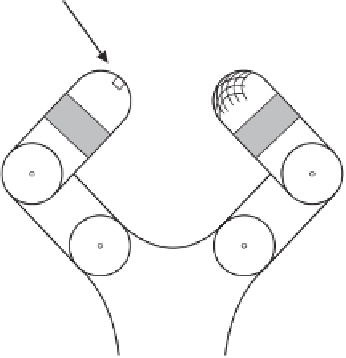Biomedical Engineering Reference
In-Depth Information
operations routine and, in addition, these procedures are less traumatic for the patient and
their outcome is greatly improved. Also, instruments used in the da Vinci
®
telemanipula-
tor system have now been further modified for measuring forces while executing surgical
tasks [115]. Since the shaft of the surgical instruments is made of carbon fiber, force
sensors have to be very sensitive and reliable. Therefore strain gauge sensors, which are
employed for industrial force registration, are applied at the distal end of the instrument's
shaft, near the gripper, in order to display realistic forces during an operation.
A second, closely related capability is the potential of medical robots to promote sur-
gical safety, both by improving a surgeon's technical performance and by means of
active assists such as 'no-fly zones' or virtual fixtures to prevent surgical instruments
from causing unintentional damage to delicate structures. Furthermore, the integration
of medical robots within the information infrastructure of a larger CIS (computer inte-
grated surgery) system can provide the surgeon with significantly improved monitoring
and online decision supports, thus further improving safety.
A third advantage is the inherent ability of medical robots and CIS systems to promote
consistency while capturing detailed online information for every procedure. Consistent
execution (e.g., in spacing and tensioning of sutures or in placing of components in joint
reconstructions) is itself an important quality factor. If saved and routinely analyzed, the
flight data recorder information inherently available with a medical robot can be used both
in morbidity and mortality assessments of serious surgical incidents and, potentially, in
statistical analyses examining many cases to develop better surgical plans. Furthermore,
such data can provide valuable input for surgical simulators, as well as a database for
developing skill assessment and certification tools for surgeons.
10.9 Robotics
Many sensing devices have been developed for robotic manipulation. A sketch of a robot
hand with some of the most common types of contact sensor is shown in Figure 10.11.
Dynamic
tactile
sensor
Tactile
array
sensor
Finger tip
Force-torque
sensor
Angle
encoder
Figure 10.11
Schematic
drawing
of
a
robot
hand
equipped
with
several
types
of
contact
sensor [116]





